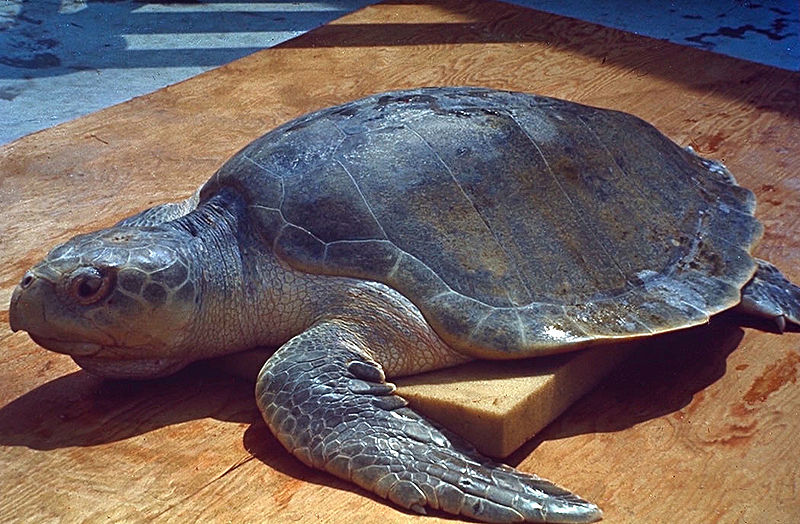 Five species of sea turtle, all threatened or endangered, inhabit waters affected by the April, 2010 oil spill in the Gulf of Mexico. In the 20 months that have passed since, many have been rescued, but problems still linger. Unfortunately, we cannot yet determine how this ecological nightmare has affected their survival prospects.
Five species of sea turtle, all threatened or endangered, inhabit waters affected by the April, 2010 oil spill in the Gulf of Mexico. In the 20 months that have passed since, many have been rescued, but problems still linger. Unfortunately, we cannot yet determine how this ecological nightmare has affected their survival prospects.
It is estimated that over 6,000 sea turtles of 5 species, along with 82,000+ birds, 26,000+ marine mammals and untold numbers of other creatures, were impacted by the Gulf Oil Spill. It is impossible to determine how many other turtles were killed as a result of fires that were set in order to burn off surface oil (the Center for Biological Diversity sued to force a change in that strategy, please see article below).
An Uncertain Future
Sad as the current state of affairs may be, potentially greater problems may lurk for the area’s animals and plants. Experience gained after the Exxon Valdez disaster has shown that the effects of massive oil spills last for decades. Scarier still is the fact that we really do not understand what may happen to the Gulf’s diverse habitats in years to come.
Researchers point out that oil is composed of thousands of organic compounds, each of which may act differently when released into the environment…the implications are staggering. Also, the 2 million-plus gallons of dispersants that were pumped into the Gulf after the spill are as toxic, or more so, than the oil itself!
Ominous signs of a grim future have, however, manifested themselves in recent months. Record numbers of dead and dying sea turtles were found last winter. Only a small percentage of the recovered turtles were carrying a coating of oil on their skin, but this does not rule oil out as the culprit. From clogged bile ducts to weakened immune systems, oil contamination has been implicated in a host of health problems affecting many creatures.
Fish Studies Hint at Turtle Concerns
Fish, perhaps because of their generally shorter generation times and faster growth rates, may provide turtle researchers with a glimpse into the future. Sadly, prospects are not bright.
Red Snappers and other species are exhibiting higher-than-usual rates of several serious ailments. Deformed ovaries, growths, unusual pigmentation, bacterial diseases and high parasite loads are all more common now than in the past. While more research is needed, most of these conditions can possibly be linked to oil contamination.
Ongoing Efforts
 Meanwhile, concerned volunteers and biologists are still doing what they can. Zoos, aquariums, and rescue groups have been involved since day one, and many continue to care for animals that may be released someday, and to find permanent homes for those too debilitated to make it on their own. This is quite a drain on budgets already strained by recession-related cuts in support. Sea turtles and other marine animals are very expensive to maintain even when in the best of health (please see article below).
Meanwhile, concerned volunteers and biologists are still doing what they can. Zoos, aquariums, and rescue groups have been involved since day one, and many continue to care for animals that may be released someday, and to find permanent homes for those too debilitated to make it on their own. This is quite a drain on budgets already strained by recession-related cuts in support. Sea turtles and other marine animals are very expensive to maintain even when in the best of health (please see article below).
Long-term field research is a vital aspect of the recovery effort. The Mote Marine Laboratory is studying free-living sea turtles, sharks and other animals in an effort to learn more about the ongoing effects of oil exposure.
What of Estuaries and Freshwater?
The line between marine and freshwater habitats is blurred and ever-changing along the 1,000 mile coastline affected by the Gulf Oil Spill. Diamondback Terrapins inhabit both worlds, while amphibians and fresh water invertebrates, both very sensitive to pollutants, live in close proximity to the spill zone. So far, work has focused on the main impact area…I shudder to think of what will be found when researchers turn their attention inland.
Further Reading
Photos, including some of the same habitats just after the spill and one year later
 That Reptile Blog – Reptile, Amphibian and Exotic Pet Care and Information
That Reptile Blog – Reptile, Amphibian and Exotic Pet Care and Information


